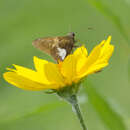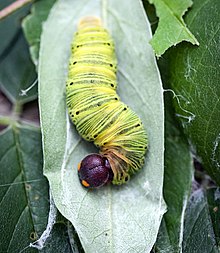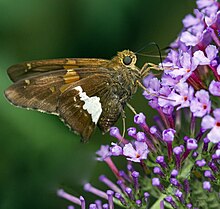pt-BR
nomes no trilho de navegação


Epargyreus clarus, the silver-spotted skipper, is a butterfly of the family Hesperiidae. It is claimed to be the most recognized skipper in North America.[2] E. clarus occurs in fields, gardens, and at forest edges and ranges from southern Canada throughout most of the United States to northern Mexico, but is absent in the Great Basin and western Texas.[3]
E. clarus larvae create and reside in unique shelters stuck together with silk, which do not protect them from predators.[4] Natural predators of the species include paper wasp foragers, sphecid wasp and Crematogaster opuntiae ants.[5][6] The species is also considered to be a perching species, meaning that adult males compete for territory to attract females.[7] Although E. clarus is considered to be a pest of a few crop plants such as beans, its pest activity is not serious enough to warrant initiating major control measures.[5]
Epargyreus clarus has a wide distribution throughout North America: it ranges from southern Canada throughout most of the United States to northern Mexico, but is absent from the Great Basin and western Texas.[3]
The silver-spotted skipper prefers open ranges where nectar plants are found, such as forest edges, swamps, brushy areas, and riparian habitats at lower elevations.[8][9]
At night, or on hot or cloudy days, Epargyreus clarus rests on the underside of a leaf. It hangs upside down, holding its wings together over its back so that its silver spot is exposed. E. clarus is often restricted by its habitat, preferring to fly in the shade.[8]
Epargyreus clarus caterpillars consume leaves of herbs, vines, shrubs, and trees in the pea family (Fabaceae) including false indigobush (Amorpha fruticosa), American hogpeanut (Amphicarpaea bracteata), groundnut (Apios americana), American wisteria (Wisteria frutescens), Atlantic pigeonwings or butterfly pea (Clitoria mariana), and the introduced Dixie ticktrefoil (Desmodium tortuosum), kudzu (Pueraria montana), black locust (Robinia pseudoacacia), Chinese wisteria (Wisteria sinensis) and an assortment of other legumes.[9]
Innate host plant preferences confer greater performance on larvae, due to differences in leaf nutrient concentrations. However, preference may be influenced by a larva’s rearing host species.[10]
They live in meadows and swamps. Their average size is 2 inches (5 cm) long. Average life span is about 2 months. Their predators are wasps, ants, birds, frogs and spiders.[11]
Adults use their long tongues to feed on the nectar of a variety of flowers, mud, and animal feces.[5] They almost never visit yellow flowers, favoring those that are blue, red, pink, purple, and sometimes white and cream. These include everlasting pea, common milkweed, red clover, buttonbush, blazing star, and thistles.[3]
Females lay a single egg on or occasionally near host plants. They have been reported to oviposit on the least snoutbean (Rynchosia minima).[12]
The eggs are green, with red coloration on top.[5]
Larvae are yellow with transverse subdorsal black stripes. The first thoracic segment is black, has a brown prothoracic shield, and is significantly thinner than its adjacent organs – the head and second thoracic segment. The head is described as black or reddish brown with two large, prominent anterior orange spots, which mimic eyes. The three true legs and midabdominal false legs are all bright orange.[9][5]
All larval instars of Epargyreus clarus build shelters on their host plant. They build about five shelters throughout larval growth and development in four distinct styles. These are constructed from instinct and are unique to larval size. The first, second, and third instars make a simple, invariant structure that requires two incisions in the leaf and silk to fold over the flap created. Shelters are typically built on the apical portion of the leaflet. One study of E. clarus larvae in the Washington D.C. area defined five steps of shelter building:[4]
Larvae take breaks of about 30 minutes between each cut and fold. It typically takes less than 21/2 hours to complete shelter construction. Larvae spend about 95% of their time resting on the ceiling of the shelter.[4]
First instar shelters are typically fastened by only about 2 to 4 "guy-wires". In addition, older caterpillars occasionally live in a nest made of multiple leaves connected by silk, especially when using host plants with smaller leaflets. For example, first, second, and third instars can make shelters with one Robinia leaflet, but the fourth and fifth instars have to use 2–4 or 5 leaflets.[4]
Larvae of Epargyreus clarus pupate throughout the winter. The pupa is dark brown with black and white marks. There are three or more overlapping generations of hibernating pupa in Florida – fewer in the northern regions.[5]
The adult wingspan ranges from 1.75 to 2.625 inches (4.5 to 6.7 cm). Each forewing is triangular and dark brown with a large yellow-orange medial patch. Male forewings are more pointed than those of females. The hindwings are also dark brown, with a large silver patch on the discal third of the ventral side.[9][5]
Adults are diurnal and fly from early to midsummer.[9] They have one brood per year in the North and West, two in the East, and three to four in the Deep South.[3]
Common predators of Epargyreus clarus include the paper wasp foragers Polistes fuscatus and Polistes dominula, as well as Crematogaster opuntiae ants. Studies have found that shelters protect larvae from these predators in lab settings. Shelters delayed or prevented Crematogaster opuntiae colonies from detecting the larvae. This is likely because of the ants' limited senses, in conjunction with the inhibitory structure of the shelter: they are able to detect a motionless caterpillar only within approximately one body length, and this is further obstructed by the single small opening into the shelter. While wasps in the laboratory setting did spend more time on areas of the leaf damaged by feeding or silk deposition, the larval shelter prevented visual detection and posed a physical barrier. However, shelters did not protect against these predators in the field. Wasps need spend only a few seconds on a leaflet to successfully identify and remove the larva from its shelter. This suggests that shelter identification and larval extraction is a learned ability, perhaps developed through visual or olfactory cues.[6]
Other predators include the sphecid wasp Stictia carolina, which sometimes supplies its nests with silver-spotted skipper larvae. Additional predators also often are attracted to the chemical cues from frass, or insect excrement. Epargyreus clarus larvae use an anal comb to throw their frass up to 38 body lengths away from them. When disturbed, larvae regurgitate an unpleasant, greenish chemical in defense.[5]
E. clarus larvae are a natural host of Baculovirus. The advanced stages of this infection cause larvae to feed without resting. Later, they climb to higher and more exposed areas, where they are more conspicuous to predators. Predator attack leaves their infected remains to be absorbed by the surrounding vegetation, which will be consumed by new hosts.[5]
Instead of receiving ejaculate, a female receives a large spermatophore from a male for each copulation. Thus, the number of spermatophores a female contains roughly equates to the number of copulations. Generally, when there are more than two spermatophores present in a female, each one’s placement and degree of erosion indicates its age relative to the other. Epargyreus clarus is particularly resistant to erosion. Once mated, females seem to reject males, at least for some time afterwards.[13]
Males perch on branches and tall weeds about 3.3 to 6.6 feet (1 to 2 m) above the ground, darting out when any insect passes in hopes of finding a receptive Epargyreus clarus female. When confronted by another conspecific, male movements are swift and acrobatic. This perching behavior is part of a common mate-location strategy in which males compete for places where females are more likely to occur.[7] Females do not engage in this behavior, but may have to fly considerable distances to find mates, depending on the proximity of male territory to their larval development site. The places "defended" by males are roughly the size of a small room and are most likely chosen based on vegetation and topography.[8]
Epargyreus clarus possesses compound eyes that lack pigment in the iris region. Each ommatidia, or single optical unit, has its own unique visual field that spans about 2°. The small visual field can be due to crystalline tracts in the eye that restrict the light to reach the retina only through this path.[14]
Epargyreus clarus is known to be a nectar-thief species. An individual nectar thief is an animal that takes nectar from a flower but does not pollinate it while doing so. A species as a whole can be considered a thief species if it does not pollinate a species of flowers during more than 50% of its feedings. Research has found that while foraging on flowers, the butterfly tended to probe the innermost disk florets, which are the male organs, but not make contact with the outermost florets, which are the female organs.[15]
Epargyreus clarus is known to feed on various crop plants such as soybean and kidney bean. However, no large-scale control measures have been taken, as the species' pest activity is not too detrimental.[5]
Epargyreus clarus, the silver-spotted skipper, is a butterfly of the family Hesperiidae. It is claimed to be the most recognized skipper in North America. E. clarus occurs in fields, gardens, and at forest edges and ranges from southern Canada throughout most of the United States to northern Mexico, but is absent in the Great Basin and western Texas.
E. clarus larvae create and reside in unique shelters stuck together with silk, which do not protect them from predators. Natural predators of the species include paper wasp foragers, sphecid wasp and Crematogaster opuntiae ants. The species is also considered to be a perching species, meaning that adult males compete for territory to attract females. Although E. clarus is considered to be a pest of a few crop plants such as beans, its pest activity is not serious enough to warrant initiating major control measures.
 Silver-spotted skipper - Hodges#3870 (Epargyreus clarus) Caterpillar feeding on Wisteria
Silver-spotted skipper - Hodges#3870 (Epargyreus clarus) Caterpillar feeding on Wisteria  Silver-spotted skipper - Hodges#3870 (Epargyreus clarus) Feeding on Butterfly Bush
Silver-spotted skipper - Hodges#3870 (Epargyreus clarus) Feeding on Butterfly Bush
Epargyreus clarus (Cramer, 1775) è un lepidottero appartenente alla famiglia Hesperiidae, diffuso nel continente americano.
È una farfalla di colore bruno scuro. L'apertura alare può misurare dai 4,5 ai 6 cm. Le ali anteriori presentano macchie arancioni e, verso l'apice, un gruppo di tre piccole macchie bianche. Sul lato inferiore delle ali posteriori è presente anche una macchia bianco-argentea. Le antenne hanno l'apice ricurvo e le ali di entrambi i sessi portano delle "code" molto tozze e corte.
Il bruco è di colore verde chiaro con testa rossiccia e presenta dei disegni più scuri sul corpo.
L'adulto ha abitudini diurne. Nelle regioni a clima temperato vi è una sola generazione annuale, mentre in territori più meridionali a clima più caldo possono esserci due o tre generazioni all'anno.
È diffusa nelle foreste dell'America centro-meridionale e nel sud degli Stati Uniti.
Epargyreus clarus (Cramer, 1775) è un lepidottero appartenente alla famiglia Hesperiidae, diffuso nel continente americano.
Epargyreus clarus ir resngalvīšu dzimtas zvīņspārnis. Spārnu plētums sasniedz 37—45 mm.[1]
Kāpuri ir dzeltenīgi vai bāli zaļi ar tumši brūnu galvu, uz kuras ir divi spilgti oranži traipi. Acis ir lielas. Dzīvo ligzdās uz barības augiem, kuras taisa no lapām. Barojas ar tauriņziežu dzimtas augiem, tādiem kā Robinia pseudoacacia, Amphicapraea bracteata, Apios americana, Desmodiom canadense, Amorpha fruticosa, Glycurrhiza lepidota.[1]
Epargyreus clarus ir resngalvīšu dzimtas zvīņspārnis. Spārnu plētums sasniedz 37—45 mm.
Kāpuri ir dzeltenīgi vai bāli zaļi ar tumši brūnu galvu, uz kuras ir divi spilgti oranži traipi. Acis ir lielas. Dzīvo ligzdās uz barības augiem, kuras taisa no lapām. Barojas ar tauriņziežu dzimtas augiem, tādiem kā Robinia pseudoacacia, Amphicapraea bracteata, Apios americana, Desmodiom canadense, Amorpha fruticosa, Glycurrhiza lepidota.
Epargyreus clarus is een vlinder uit de familie Hesperiidae, de dikkopjes. De soort komt voornamelijk voor in Canada en de Verenigde Staten.
De spanwijdte varieert van 43 tot 67 millimeter.
Epargyreus clarus – gatunek motyla z rodziny powszelatkowatych (Hesperiidae). Wyróżnia się cztery podgatunki[1]:
Rozpiętość skrzydeł tego motyla wynosi do 63 mm. Ubarwienie skrzydeł brązowe. Na dolnej stronie tylnych skrzydeł występuje duża srebrna plama. Na dolnej stronie przednich skrzydeł jest złota plama. Motyl lata od kwietnia do grudnia.
Gąsienica barwy żółto-zielonej w poprzeczne ciemne paski. Głowa brązowoczerwona z dwoma pomarańczowymi plamami.
Występuje na terenie Ameryki Północnej, od południowej części Kanady, przez większość obszaru USA po północny Meksyk. Nie występuje w Wielkiej Kotlinie i zachodnim Teksasie[3]. Rozpowszechniony we wschodniej części kontynentu, rzadziej spotykany w zachodniej. Spotykany na obrzeżach lasów, w ogrodach i na polach.
Epargyreus clarus – gatunek motyla z rodziny powszelatkowatych (Hesperiidae). Wyróżnia się cztery podgatunki:
Epargyreus clarus californicus (Smith, 1891) Epargyreus clarus clarus (Cramer, [1775]) Epargyreus clarus huachuca (Dixon, 1955) Epargyreus clarus profugus (Austin in T. Emmel, 1998)Rozpiętość skrzydeł tego motyla wynosi do 63 mm. Ubarwienie skrzydeł brązowe. Na dolnej stronie tylnych skrzydeł występuje duża srebrna plama. Na dolnej stronie przednich skrzydeł jest złota plama. Motyl lata od kwietnia do grudnia.
Gąsienica barwy żółto-zielonej w poprzeczne ciemne paski. Głowa brązowoczerwona z dwoma pomarańczowymi plamami.
Występuje na terenie Ameryki Północnej, od południowej części Kanady, przez większość obszaru USA po północny Meksyk. Nie występuje w Wielkiej Kotlinie i zachodnim Teksasie. Rozpowszechniony we wschodniej części kontynentu, rzadziej spotykany w zachodniej. Spotykany na obrzeżach lasów, w ogrodach i na polach.
Epargyreus clarus este o specie de fluture din familia Hesperiidae. Se crede că ar fi cel mai recunoscut fluture din familia sa din America de Nord.[1]
Anvergura unui adult este de 43–67 mm. Adulții au pete aurii pe aripile superioare și benzi argintii pe cele inferioare. [2]
Adulții acestei specii sunt răspândiți pe câmpuri, în grădini și la marginea pădurilor. Este întâlnită din sudul Canadei prin majoritatea Statelor Unite și până în nordul Mexicului, dar este absentă în Marele Bazin și vestul Texasului. [2]
Adulții nu se hrănesc aproape niciodată din flori galbene. [2] Printre speciile preferate se numără:
![]() Materiale media legate de Epargyreus clarus la Wikimedia Commons
Materiale media legate de Epargyreus clarus la Wikimedia Commons
Epargyreus clarus este o specie de fluture din familia Hesperiidae. Se crede că ar fi cel mai recunoscut fluture din familia sa din America de Nord.
Bướm nâu đầu bạc (Epargyreus clarus) là một loài bướm thuộc họ Bướm nhảy. Người ta cho rằng nó là loài bướm nâu được nhận thấy nhiều nhất ở Bắc Mỹ.[1]
Con trưởng thành có sải cánh dài khoảng 43–67 mm. Có trưởng thành có các đốm vàng trong mờ ở cánh trước và các dải bạc ở cánh sau.[2] Con sâu bướm có đaauf lớn màu nây với các đốt màu cam như mắt giả. Thân dài màu xanh lá cây.
Con trưởng thành xuất hiện ở các cánh đồng, vườn, rìa rừng. Nó phân bố từ miền nam Canada qua hầu hết Hoa Kỳ to miền bắc México; nó không có ở Đại Anh và miền tây Texas.[2]
Con trưởng thành bay vào các thời kỳ ấm trong năm.[2] Con cái đẻ trứng gần nơi cây chủ của saau bướm. Con sâu bướm tự bò tới cây chủ. Con sâu cuộn lá cây chủ làm tổ, cuộn bằng tơ.[2] They overwinter as chrysalids.
Ấu trùng ăn lá nhiều cây bụi. Cây chủ gồm:
Adults almost never feed on yellow flowers.[2] Among their favorites are:
|coauthors= bị phản đối (trợ giúp) |coauthors= bị phản đối (trợ giúp)
Bướm nâu đầu bạc (Epargyreus clarus) là một loài bướm thuộc họ Bướm nhảy. Người ta cho rằng nó là loài bướm nâu được nhận thấy nhiều nhất ở Bắc Mỹ.
飴弄蝶(学名:Epargyreus clarus)为弄蝶科飴弄蝶屬下的一个种。
|access-date=中的日期值 (帮助)